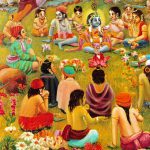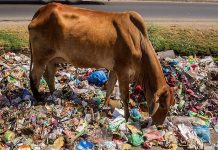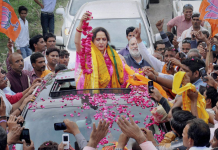All of us who love Krishna and Vrindavan have two homes: one in this temporary world and another in the eternal realm. This is the reason that we want to physically be in Vrindavan or at least absorbed in thoughts of Vrindavan and Radha Govinda’s holy names when we leave this world. In this way, we prepare ourselves to leave the material world and claim our places in the eternal realm.
In the meantime, as we await our return to the eternal realm and work on perfecting our devotion and understanding (in the manifest Vrindavan and Braj Mandal if we are so blessed), we have certain responsibilities to the holy Dham that we must fulfill.
The Braj Vrindavan Heritage Alliance (BVHA – online at bvhalliance.org) and Vrindavan Today (online at vrindavantoday.com) exist to remind us of those responsibilities, connecting us all through a worldwide network of permanent residents, visiting yatris, and even devotees who meditate about Braj from distant places. The BVHA and Vrindavan Today work to organize all who possess honesty, goodwill and respect for life, cleanliness and beauty in the Dham so that they may act together effectively to improve the condition of the Dham on every level.
It is time that we get involved to make Vrindavan look as glorious as the scriptures’ descriptions of it. What can we do? We can hold the government accountable and protest when necessary, definitely. But waiting for the government to do everything is neither practical nor fair. We also have to look at ourselves and recognize that we the people are also part of the problem, and as such, it is our duty to become part of the solution as well. So at one hand, we have to make a conscious effort each day to act in ways that turn ideas for a beautiful Vrindavan and Braj into reality. On the other hand, in a joint effort of the civil society, we also have the responsibility and capacity to draw up and present structural propositions to relevant officials and politicians, as we obviously also need help from their side if we want an integral, structural and sustainable solution.
The main issue is to draw up a Master Plan with a combined effort of the ecologists, those who want to preserve the heritage, the government, the experts, the designers and those who search for technical solutions to facilitate the progress of Braj. This Master Plan is the first real serious target in order to solve the different problems Vrindavan is facing; and to develop this Master Plan, a platform like the BVHA – Braj Vrindavan Heritage Alliance is unavoidable. Because when the government agencies plan, nobody finds out about what they want to do until it is actually done. Like the fiasco of the bridge and many other examples.
So, let us all become the conscious members of the solution for Vrindavan and Braj, and start to act!
What Are the Most Urgent Issues That We Can Impact in a Positive Way With Responsible Behavior?
1) We have to stop littering plastic bags, bottles and packets everywhere.
2) We have to stop using plastic cups and plates, which stay visible for many years in the beautiful river and lands of Braj. Instead we must restore incomes and livelihoods to those who make biodegradable clay cups and leaf plates and bowls, even if it means paying slightly more.
3) We have to clean in front of our homes, ashrams and temples.
4) We have to get septic tanks that will prevent raw sewage from being sent into the street.
5) We must stop making noise with our speakers which obstructs the meditation and peace of others, especially sick and old people.
6) We must drive in ways that do not threaten the physical, emotional or spiritual well being of others. Even a bicycle should not be driven without proper respect and awareness.
7) We should participate in the citizen awareness meetings of the Braj Vrindavan Heritage Alliance and join action committees working on specific tasks aimed at preserving, maintaining and glorifying the Dham.
8) We must not allow our devotion and pilgrimage to be used as an excuse by the government as they destroy the numerous charming small alleys and cut the beautiful kalpavriksa trees of Vrindavan to offer free and speedy movement to cars. We must demonstrate our commitment and be ready to walk or take rickshaws from designated parking places to our destinations in Vrindavan.
9) We must identify unique areas of knowledge and talent that will make us a successful part of the solution, inviting any and all contacts with interest and/or influence in the Dham to also take part. We must also inform ourselves and talk with others to learn how we can best donate time, money or expertise to organizations that get real work done.
What Are the Most Urgent Issues Upon Which We Must Get the Government to Act?
1) Despite having an official dumping ground for Vrindavan’s garbage near Pagal Baba Mandir, still illegal dumping is taking place in many parts of the city. This should be stopped.
2) Recycling should be promoted on all levels, and preferably Vrindavan should have its own recycling plant. If poor people could make some money by collecting all the littered plastic, it could greatly help the cleaning efforts.
3) Sewage must be kept from flowing into the Yamuna. We expected this situation to be taken care of by Yamuna Action Plan, but this expensive government initiative was carried out without any noticeable reduction in the amount of sewage entering the Yamuna. The dumping of raw sewage into the Yamuna is an illegal practice that kills the river as well as all life depending upon it. People who drink from the river or the polluted groundwater become ill and sometimes die. Entire species of fish, turtles, and dolphins are killed in such great numbers that they are driven to near extinction.
4) Returning Yamuna back to the old ghats must be made a priority; we must forget our private interests and rivalries and in order to request the government to undertake this important project we have to use a single strong, clear voice. The land opposite the Yamuna from Vrindavan can still be protected from developers and turned into a real Van forest that can also act as a protective Greenbelt. We must communicate that we are not anti-development but rather pro- RESPONSIBLE development. Development is necessary but it must be approved by real experts who consider heritage, health, beauty and utility for the movement of all who live in or visit Sri Vrindavan Dham.
5) Traffic congestion, noise, disorganization and recklessness must be eliminated by strongly enforced regulations. Car, bike and cycle users must be made to comply with laws that protect yatris and the paths they traverse. Car owners should be required to pay for parking space: Why should they be allowed to obstruct the whole town and the small alleys by carelessly parking their vehicles anywhere they like? Money is a necessary component of any plan to restore, preserve, beautify and maintain the Dham and a logical way to raise funds would be to require all those contributing to problems in the Dham to also contribute to the solutions for those problems. The proposed parking fee mentioned here is but one suggestion on how a framework of required fees can pay for the beautification and upkeep of Vrindavan.
6) A ban must be placed on the use of plastic plates, cups and bags in the Dham. When carelessly disposed of, these items degrade the sacred Parikrama road and even the entrances and courtyards of famous and historic temples. Furthermore, the burning of plastic as it is commonly done in Vrindavan releases dangerous chemicals that are then allowed to degrade local air quality and seep into the groundwater with the rains, poisoning humans, animals and plant life. The use of plastic should be minimized and its proper disposal and recycling should be ensured.
Why is it Important That We Do Something Now?
We must remember that we are all the sons and daughters of Sri Sri Radha Govinda and that Vrindavan is our home. If Vrindavan looks neglected, it means that we are neglecting our duty as good children.
Sri Krishna is Bhagavan, the Lord of the whole universe. The great souls that founded Vrindavan’s oldest temples in Sri Krishna’s name wanted to make this place the most beautiful in the world; they were able to accomplish their goal. Their mandirs are still the greatest architectural contributions of their time, crafted with a beauty that to this day remains unmatched.
Can you imagine Gopal Bhatta Goswami, Swami Haridas or Jiva Goswami sitting next to garbage and raw sewage flowing into Yamuna Maharani? Of course you can’t. This is because these great souls were living examples of perfect devotion, so they would clean the Dham with their own hands. So follow their example, even if your efforts only clear a small part of the waste. Their tradition of cleaning Seva Kunja is still a custom kept alive today.
Times have changed drastically since the days of the founders of Vrindavan’s first temples; clay cups and leaf plates are now absent from most bandaras (feasts) and environmentally sustainable dry toilets utilizing natural pig recycling are now a thing of the past.
Today, everybody wants to have a modern toilet that transforms each instance of human waste into a loss of ten liters of precious water that gets flushed down the drain, eventually flowing into the nali as disease-breeding raw sewage. This sewage eventually makes it all the way to the river where it offends sacred Yamuna Maharani. Think about it. Would any devotee defecate or urinate in the sacred river? Modern toilet systems may look clean in bathrooms, but they create a dirty disaster that is wasteful, offensive and dangerous unless the sewage is professionally purified before it reaches the river.
Bhagavan Sri Krishna and his devotees, a group which over the centuries has included several saints and Kings, are the true guardians of Vrindavan. Do not allow this unique city to become a disaster zone rather than a most attractive preserved jewel for the people of India and the world to visit and purify their consciousnesses.
In Europe, many schools took all of their students out to collect garbage. Through this activity, the children taught adults that garbage should not be thrown into the street. Garbage-filled streets make everything look like a disaster that not even the most destitute people would tolerate in their private homes. This is why one of Vrindavan’s most active NGOs takes its school children out to collect garbage once a month. Other schools should join in using the power of education to affect the positive changes we wish to see in Vrindavan.
We have arrived at the last moment to act; we are surrounded on all sides by forces that concentrate on making quick money for a select few while the majority is left to suffer and the Dham is destroyed. We urgently need all to unite and participate in creating and advocating sensible development plans and in educating others about workable and heritage conscious solutions for a prosperous, beautiful Braj Vrindavan.
All problems have solutions, but unity and increased awareness are necessary for transforming ideas for solutions into actions that affect a change of consciousness about or day-to-day treatment of the Dham.
Many more topics, such as the removal of the concrete pillars which obstruct Yamunajis natural flow, must be addressed, but let that be taken care by those who really care. Hopefully you are someone who counts yourself as belonging to this group.
How Can We Ensure That We Are Involved in the Discussion and Become an Active Part of Workable Solutions for Braj Vrindavan?
1) Keep in touch.The Braj Vrindavan Heritage Alliance has an online form that allows membership creation and submission of opinions and other input. The from can be accessed via the BVHA homepage, located at BVHAlliance.org
2) Be patient. Changing habits and practices related to group mentality is a process that takes years (Yes, even when that mentality is based on absent, inadequate or false information, as is often the case here).
3) Be enthusiastic. Keep in mind that several great things have already happened here and keep expanding. The last few decades have seen the establishment of initial cleaning efforts; great schools; great medical assistance programs; great prasadam distribution programs, and great new temples constructed in beautiful traditional and modern architectural styles.
4) Look at the list of our supporters and what they are doing to see how you can help efforts like these to move forward.











